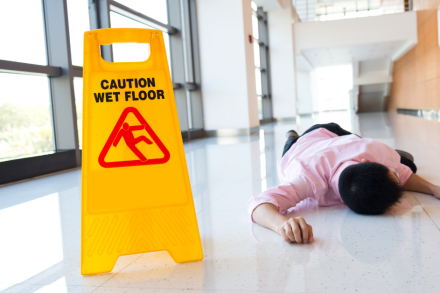
According to OSHA, slips, trips, and falls constitute the majority of general industry accidents. They cause 15% of all accidental deaths, and are second only to motor vehicles as a cause of fatalities.
According to the Bureau of Labor Statistics, Slips, trips, and falls accounted for about 27 percent of cases involving days away from work in 2014.
No matter what industry you are in, slips, trips, and falls account for one (1) of your greatest workers’ compensation exposures. Slip, trip, and fall related injuries can be very serious resulting in a head injury, broken bones, torn ligaments and tendons, serious neck, back, and spine injuries, and even death. By taking the time to educate the staff and conduct worksite inspections and correction, you reduce the risk of a slip/trip/fall event.
SAIF Corporation provides a great slip, trip, and fall booklet for employers to use as a guide to help identify potential slip/trip/fall hazards and prevent these types of injuries from occurring. The provided assessment checklist in the booklet focuses on eight (8) areas summarized below.
Work areas and housekeeping:
- Clear expectations of housekeeping standards (employee accountability)
- Clearly identified walkways and aisles
- Exits and exit pathways clear
- Immediate work area clear of trip hazards
Cords:
- Walkways free from cords
- Hoses and cords rolled up when not in use
- Install permanent wiring to eliminate the use of extension cords
- Cords covered and secured that cross a walkway
Walking and slip hazards:
- Employee training on what to do if discover a spill
- Wet floor signs used and available (removed when floor is dry)
- Floor mats in good condition
- Good lighting in transition areas
Footwear:
- Policy defining appropriate footwear, staff training,, and accountability
- Footwear inspections (employee compliance)
- Specialty footwear (overshoes for snow and ice, etc.)
Parking lot and grounds:
- Inspect for slip, trip, fall hazards
- Edges of curbs and bumpers highly visible
- Well lit, especially during winter months
- Inclement weather plan, training, and supplies
Stairs:
- Handrails in place
- Steps and stair nosings in good repair
- Staff training (using handrails and safely carry materials)
- Lighting adequate
Ladders:
- Appropriate ladders available for given job
- Ladder safety training
- Ladder inspection
Training:
- Staff training on rules such as “no running” and “look where you are going and go where you are looking”
- Staff training on benefits of changing gait and ankle movements when walking on slippery surfaces
Resources:
https://www.osha.gov/walking-working-surfaces/index.html
http://beta.bls.gov/labs/blogs/2015/12/11/why-this-counts-slips-trips-and-falls-in-the-workplace/
http://www.saif.com/Documents/SafetyandHealth/SlipsTripsandFalls/S918_booklet_slip_trip_fall.pdf





